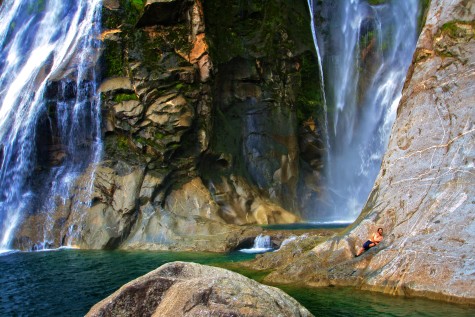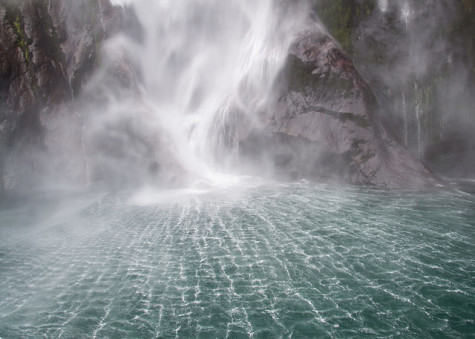It has been raining for three days now, really raining, the kind of rain that can only occur in a place that receives upwards of 7 meters of rain a year. Three days ago, water began pouring out of the sky the way it might during a tropical afternoon storm or a monsoon — a kind of rain that comes quickly and leaves a short while later. But this rain doesn’t leave.
I’m spending a summer in Fiordland National Park, on New Zealand’s South Island, and the Kiwis I live with want to show me how powerful water can be in one of the wettest places on the planet. So on Monday, having played board games, baked and watched movies for far too long, we gear up. Everyone digs out the most protective waterproof combination they can find. I put on a dry suit, neoprene booties, neoprene gloves, a neoprene balaclava and my diving mask. Then we pile in the back of a van and drive to Bowen Falls.
At 160 meters tall, Lady Bowen Falls is three times higher than Niagara. It’s fed by a glacier, but the sheer mountains surrounding it lack soil, so when it rains hard like this, Bowen floods quickly. The mountains funnel rainwater into an ever-swelling river that churns through an alpine valley, then shoots like a firecracker into the sky before dropping over a ledge the height of a 50-story building.
Bowen Falls is not only a magnificent example of hydrology; it also supplies the community of Milford Sound with drinking water and electricity. About 150 people live in Milford, and all of us flush our toilets and shower with pure, untreated glacier melt that has been locked up as ice for 30,000 years. Humans only arrived in New Zealand 800 years ago, so the water coming off Bowen Falls today has never before touched another person.
Back home in the American West, most of the water we drink has passed through multiple people; some communities are so thirsty they’re drinking recycled sewage. People still believe we can bend water to our will, holding back rivers with dams, channeling and riprapping them until they’re sapped nearly dry. But here, in the land of the long white cloud, the rivers are alive; one of them has even been granted the same legal rights as people. Here, we can not only turn on the tap and drink glacier water, but when it rains hard and there’s no work and the one road into this place is closed by rock slides, we can venture into one of the rawest, wildest displays of nature on earth. We can go under Bowen Falls while it’s flooding.
I’ve known this for weeks. I think I’m ready. I’ve been warned to cover every possible piece of skin.
But nothing can prepare me for the reality of it. Seven of us clamber out of the van and hop a metal gate to the start of an old boardwalk. As we follow it toward the falls — winding between a dripping cliff and the loamy, pulsing ocean — water becomes the only sound. Rain pelts the leaves and splatters into a forest that has become swampland practically overnight.
The wind picks up as we approach. Bowen Falls creates its own winds, gusting over 100 kilometers per hour at its base. Trees become gnarled bonsai, their branches and trunks swept away from the falls and frozen in fantastic shapes, as if reaching their arms toward the sea in an attempt to get away from this reckless display of power.
And then there is nothing. Even with a diving mask, I can’t see anything but driving water against a backdrop of gray. I can hardly breathe; I must constantly spit out mouthfuls of water. I concentrate on putting one foot in front of the other, battling against the force of the wind, leaning into it with all my weight. At some point, the boardwalk ends and we struggle on, onto the rocks and grass that surround the base of the falls. Often the wind bowls us over and we sit clutching tussocks of grass, clawing our way forward. We can’t see each other’s faces, aware only of the vague blurs of color and groping hands that we know belong to fellow human beings. Here, in one of the wettest environments in the world, there’s no doubt that water is more powerful than anything we can build. And even as it knocks me off my feet, I am somehow, strangely, reassured.
Krista Lee Langlois is an independent journalist and correspondent at High Country News. You can find more of her work at kristaleelanglois.com.
Bowen Falls image, top, by the author. Stirling Falls image courtesy of Flickr user Gabrielle Ludlow (Creative Commons).


nice bud :)xooxoxoxoxoxoxoxoxoxoxoxoxoxoxoxoxoxoxoxoxoxoxoxoxoxoxoxoxoxoxxoxoxoxoxoxoxoxoxoxoxoxoxoxoxoxo